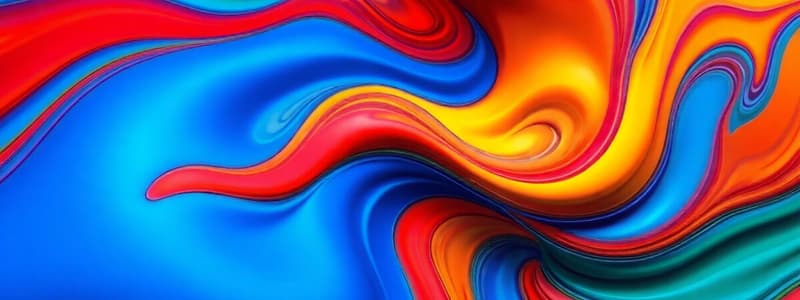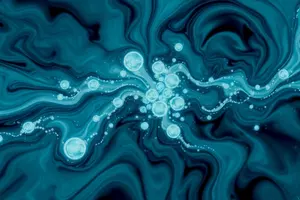Podcast
Questions and Answers
In which field is Computational Fluid Dynamics (CFD) primarily applied in analyzing vehicle aerodynamics?
In which field is Computational Fluid Dynamics (CFD) primarily applied in analyzing vehicle aerodynamics?
Aerospace
What is one of the environmental effects that CFD helps to simulate?
What is one of the environmental effects that CFD helps to simulate?
Weather
How is CFD utilized in the biomedical field?
How is CFD utilized in the biomedical field?
To study temperature and natural convection currents in the eye following laser heating.
Which industrial process involves the use of CFD for predicting flow separation and residence time effects?
Which industrial process involves the use of CFD for predicting flow separation and residence time effects?
Name a sector where CFD is applied to optimize ventilation systems.
Name a sector where CFD is applied to optimize ventilation systems.
What role does CFD play in the automotive industry?
What role does CFD play in the automotive industry?
Identify a hazardous scenario where CFD can be applied.
Identify a hazardous scenario where CFD can be applied.
In marine applications, what aspect of fluid dynamics does CFD typically simulate?
In marine applications, what aspect of fluid dynamics does CFD typically simulate?
What are the key stages in the modeling workflow of 3D CAD?
What are the key stages in the modeling workflow of 3D CAD?
Explain the importance of digital prototypes in CAD.
Explain the importance of digital prototypes in CAD.
Describe one technique for constructing wireframe objects in a 3D environment.
Describe one technique for constructing wireframe objects in a 3D environment.
What are some basic machining tools and their roles in digital manufacturing?
What are some basic machining tools and their roles in digital manufacturing?
What is Industry 5.0, and how does it relate to digital manufacturing?
What is Industry 5.0, and how does it relate to digital manufacturing?
How do 3D printing technologies differ, specifically between FDM and SLA?
How do 3D printing technologies differ, specifically between FDM and SLA?
Identify a benefit of using CAD in the biotechnology sector.
Identify a benefit of using CAD in the biotechnology sector.
What role does simulation play in the application of digital manufacturing?
What role does simulation play in the application of digital manufacturing?
What is the purpose of the G00 code in CNC programming?
What is the purpose of the G00 code in CNC programming?
Differentiate between G41 and G42 codes in CNC machining.
Differentiate between G41 and G42 codes in CNC machining.
What is the function of the M08 code?
What is the function of the M08 code?
Explain the significance of the N-code in an NC program.
Explain the significance of the N-code in an NC program.
What does the G90 code signify in CNC programming?
What does the G90 code signify in CNC programming?
What is the purpose of the G81-G89 codes?
What is the purpose of the G81-G89 codes?
What do the X, Y, and Z codes represent in CNC programming?
What do the X, Y, and Z codes represent in CNC programming?
What is the role of the F-code in CNC machining?
What is the role of the F-code in CNC machining?
What is the significance of selecting different CFD codes for various applications such as aerospace and marine?
What is the significance of selecting different CFD codes for various applications such as aerospace and marine?
List the six main steps involved in the CFD process.
List the six main steps involved in the CFD process.
Why is the selection of an appropriate coordinate system important in CFD geometry setup?
Why is the selection of an appropriate coordinate system important in CFD geometry setup?
What factors should be considered when determining flow conditions in CFD applications?
What factors should be considered when determining flow conditions in CFD applications?
How do dimensional and non-dimensional variables differ in their presentation in CFD software?
How do dimensional and non-dimensional variables differ in their presentation in CFD software?
In CFD, what is meant by post-processing?
In CFD, what is meant by post-processing?
What simplifications may be needed when determining domain size and shape in CFD geometry?
What simplifications may be needed when determining domain size and shape in CFD geometry?
What role do fluid properties such as density and viscosity play in the CFD process?
What role do fluid properties such as density and viscosity play in the CFD process?
What is a distinct advantage of 3D printing in terms of design capabilities?
What is a distinct advantage of 3D printing in terms of design capabilities?
What is the primary disadvantage of Fused Deposition Modeling (FDM) regarding part quality?
What is the primary disadvantage of Fused Deposition Modeling (FDM) regarding part quality?
Which resin is used in the Stereo Lithography process?
Which resin is used in the Stereo Lithography process?
Name an application of additive manufacturing in the medical field.
Name an application of additive manufacturing in the medical field.
What is one key benefit of rapid prototyping in additive manufacturing?
What is one key benefit of rapid prototyping in additive manufacturing?
How does 3D printing minimize waste compared to traditional manufacturing?
How does 3D printing minimize waste compared to traditional manufacturing?
What advantage does additive manufacturing offer for production speed?
What advantage does additive manufacturing offer for production speed?
What challenge is associated with operating 3D printers effectively?
What challenge is associated with operating 3D printers effectively?
In what way does 3D printing enhance customization?
In what way does 3D printing enhance customization?
What future application is suggested for additive manufacturing technology?
What future application is suggested for additive manufacturing technology?
What is batch production and in which industries is it primarily used?
What is batch production and in which industries is it primarily used?
How does demand influence batch production?
How does demand influence batch production?
Give an example of a company that utilizes batch production and explain why.
Give an example of a company that utilizes batch production and explain why.
What are some key features of batch production?
What are some key features of batch production?
What is mass production and how does it typically function?
What is mass production and how does it typically function?
How does specialization play a role in mass production?
How does specialization play a role in mass production?
What is a significant cost concern associated with batch production?
What is a significant cost concern associated with batch production?
Why is mass production particularly suited for the automobile industry?
Why is mass production particularly suited for the automobile industry?
Flashcards
What is a G-Code?
What is a G-Code?
A preparatory word used to communicate with the Machine Control Unit (MCU) and prepare it for a specific control function. Examples include G01 for linear interpolation, G02 for circular interpolation (clockwise), and G03 for circular interpolation (counterclockwise).
What is an N-Code?
What is an N-Code?
Used to define the sequence number of each block within an NC program. It allows for easy identification and location of program commands. Best practice is to increment each block number by 5 to 10 to allow space for potential future changes.
What are X, Y, and Z-Codes?
What are X, Y, and Z-Codes?
Used to specify the coordinate positions of the tool during machining operations. They typically involve the X, Y, and Z axes.
What is an F-Code?
What is an F-Code?
Signup and view all the flashcards
What is an S-Code?
What is an S-Code?
Signup and view all the flashcards
What does G40 do?
What does G40 do?
Signup and view all the flashcards
What does G70 do?
What does G70 do?
Signup and view all the flashcards
What does M30 do?
What does M30 do?
Signup and view all the flashcards
3D Modeling
3D Modeling
Signup and view all the flashcards
Modeling Workflow
Modeling Workflow
Signup and view all the flashcards
Digital Manufacturing
Digital Manufacturing
Signup and view all the flashcards
Additive Manufacturing
Additive Manufacturing
Signup and view all the flashcards
Fused Deposition Modeling (FDM)
Fused Deposition Modeling (FDM)
Signup and view all the flashcards
Machining
Machining
Signup and view all the flashcards
Forming
Forming
Signup and view all the flashcards
Computational Fluid Dynamics (CFD)
Computational Fluid Dynamics (CFD)
Signup and view all the flashcards
What is CFD used for?
What is CFD used for?
Signup and view all the flashcards
CFD applications: Full-scale simulations
CFD applications: Full-scale simulations
Signup and view all the flashcards
CFD applications: Environmental effects
CFD applications: Environmental effects
Signup and view all the flashcards
CFD applications: Hazards
CFD applications: Hazards
Signup and view all the flashcards
CFD applications: Physics
CFD applications: Physics
Signup and view all the flashcards
CFD applications: Aerospace
CFD applications: Aerospace
Signup and view all the flashcards
CFD applications: Automotive
CFD applications: Automotive
Signup and view all the flashcards
CFD applications: Biomedical
CFD applications: Biomedical
Signup and view all the flashcards
CFD Process
CFD Process
Signup and view all the flashcards
Geometry in CFD
Geometry in CFD
Signup and view all the flashcards
Physics in CFD
Physics in CFD
Signup and view all the flashcards
Meshing in CFD
Meshing in CFD
Signup and view all the flashcards
Solving in CFD
Solving in CFD
Signup and view all the flashcards
Reporting in CFD
Reporting in CFD
Signup and view all the flashcards
Post-processing in CFD
Post-processing in CFD
Signup and view all the flashcards
Specialized CFD Codes
Specialized CFD Codes
Signup and view all the flashcards
Batch Production
Batch Production
Signup and view all the flashcards
Characteristics of Batch Production
Characteristics of Batch Production
Signup and view all the flashcards
Demand and Batch Production
Demand and Batch Production
Signup and view all the flashcards
Definition of Mass Production
Definition of Mass Production
Signup and view all the flashcards
Alternative Names for Mass Production
Alternative Names for Mass Production
Signup and view all the flashcards
Specialization in Mass Production
Specialization in Mass Production
Signup and view all the flashcards
Assembly Line Workflow
Assembly Line Workflow
Signup and view all the flashcards
Continuous Flow in Mass Production
Continuous Flow in Mass Production
Signup and view all the flashcards
What is Stereo Lithography?
What is Stereo Lithography?
Signup and view all the flashcards
What is an advantage of Stereo Lithography?
What is an advantage of Stereo Lithography?
Signup and view all the flashcards
What is the application of Stereo Lithography?
What is the application of Stereo Lithography?
Signup and view all the flashcards
What is Fused Deposition Modeling (FDM)?
What is Fused Deposition Modeling (FDM)?
Signup and view all the flashcards
What is an advantage of FDM?
What is an advantage of FDM?
Signup and view all the flashcards
What is a disadvantage of FDM?
What is a disadvantage of FDM?
Signup and view all the flashcards
What is a key advantage of 3D printing?
What is a key advantage of 3D printing?
Signup and view all the flashcards
Why is waste minimized with 3D printing?
Why is waste minimized with 3D printing?
Signup and view all the flashcards
What is the advantage of 3D printing in terms of shape?
What is the advantage of 3D printing in terms of shape?
Signup and view all the flashcards
How does 3D printing contribute to rapid prototyping?
How does 3D printing contribute to rapid prototyping?
Signup and view all the flashcards
Study Notes
Course Details
- Course name: CAD and Digital Manufacturing
- Unit: 5
- Subject code: BME-0151/0251
- Semester: I/II
Faculty Information
- Faculty name: Avdhesh Jha
- Designation: Assistant Professor
- Qualification: M.Tech (CAD), Ph.D. (NIT Patna)
- Experience: 15 years
- Coursera courses include: Digital Manufacturing & Design, Digital thread: Components, Digital thread: Implementation, Advance Manufacturing Enterprises
- Research areas: Hybrid Metal Matrix Composite by FSW/FSP/FSAM, Additive Manufacturing
Evaluation Scheme
- Total marks: 150 (PS - 50, PE - 100)
- Credits: 3
- LTP: 0-0-6
- Practical Sessional marks distribution:
- Lab Performance/Attendance and Teacher Assessment: 10 marks
- File Submission: 20 marks
- Viva: 20 marks
- End Semester marks distribution:
- Quiz: 20 marks
- Lab Performance: 40 marks
- Viva: 40 marks
- Each unit has a minimum number of 10 sheets, and each sheet should contain a minimum of 10 exercises
Unit 1: Introduction to CAD
- Introduction to Engineering Drawings
- Scale, Coordinate System
- Types of View (Orthographic, Isometric & Perspective)
- Types of Projection
- Sections of solids and Development of surfaces
- CAD Software (AutoCAD/PTC Creo/CATIA/Fusion 360/Solid Works etc.)
- GUI, Workspaces, Coordinate Systems
- File Management
- Display Control
Unit 2: Working on CAD in 2D Environment
- Sketching
- Drawing Aids
- Editing Sketched Objects
- Layers
- Creating Text and Tables
- Dimensioning and Detailing of Drawings
- Editing Dimensions
- Dimension Styles
- Adding Constraints to Sketches
- Hatching Drawings
- Paper Layout
- Plotting Drawings in AutoCAD
- Template Drawings
Unit 3: Working on CAD in 3D Environment
- 3D Modeling
- 3D Environment and Drawing
- Modeling Workflow
- Editing Models
- Assembly Sectioning a Model
- Creating Drawings
- Visualization
- Downstream
- Rectangular 3D coordinates
- 3D Construction techniques
- Constructing wireframe objects
- Constructing solid primitives
- Dynamically changing a 3D view
- Shading a 3D model
- Blueprint Drawing
- Uses of Digital Prototype
Unit 4: Introduction to Digital Manufacturing
- Workshop layout
- Engineering materials
- Fitting, Carpentry
- Forging, Casting
- Welding, Forming
- Basic Machining Tools (Lathe, Milling, Drilling, Shaper, Grinding)
- Introduction to Digital Manufacturing
- Additive manufacturing
- Basics of automation & robotics
- Concepts of Industry 5.0 (Videos & Quizzes)
Unit 5: Application of Digital Manufacturing
- 3D Modelling and simulation of various Forming
- Machining in CAD
- Overview of Computational Fluid Dynamics
- Basic introduction to 3D Printing & Technologies (FDM, LDM, SLA)
- Slicing software
- Types of Production
- Various types of Industries
- Introduction to Smart Factory
Branch-wise Applications
- CSE: CAD and digital manufacturing revolutionize product development, from initial design stages to final production.
- ECE: Enhanced efficiency, accuracy, and innovation in electronics and engineering industries.
- ME: Tools for mechanical engineers, enhancing design, reducing time to market, and promoting innovation.
- BioTech: Streamlined design and production of complex biological devices and structures.
Course Objective
- Comprehensive knowledge and practical skills in computer-aided design (CAD) and its application in digital manufacturing.
- Understanding of CAD software fundamentals and its relevance.
- Advanced techniques in modeling, simulation and prototyping.
- Effective product design for digital fabrication (3D printing and CNC machining).
- Hands-on learning with exercises and real-world case studies.
- Critical problem-solving skills in CAD and digital manufacturing.
Course Outcome(CO)
- CO1: Understand engineering drawings, projections, and CAD software for accurate technical design and visualization Knowledge of engineering drawings and CAD software is vital.
- CO2: Gain proficiency in sketching, dimensioning, editing, and detailing drawings in CAD, including advanced layout and plotting techniques. Proficiency in creating 2D CAD drawings is a significant skill.
- CO3: Apply skills in 3D modeling, visualization, and assembly, mastering techniques for creating and editing complex digital prototypes and blueprints. Mastering 3D modeling is a critical skill.
- CO4: Understand workshop practices, machining tools, and materials, with insights into digital manufacturing, automation, and Industry 5.0 innovations. This shows a comprehensive understanding of various processes.
- CO5: Demonstrate and apply 3D printing, understand various production types, and explore smart factories and industry technologies for advanced manufacturing. Proficiency and knowledge of 3D printing techniques are important.
Program Outcomes (POS)
- Engineering knowledge
- Problem analysis
- Design/development of solutions
- Conduct investigations of complex problems
- Modern tool usage
- The engineer and society
- Environment and sustainability
- Ethics
- Individual and team work
- Communication
- Project management and finance
- Life-long learning
CO-PO Mapping, CO-PSO Mapping
- Mapping of course outcomes to program outcomes, and course outcomes to program-specific outcomes
Unit Contents
- Course objectives
- Course outcomes
- CO-PO Mapping
- CO-PSO mapping
- Unit prerequisite and pre-cap
- Syllabus of Unit 5
- 3D Modeling
- CFD
- 3D Modelling and simulation of various Forming
- Machining in CAD
- Basic introduction to 3D Printing
- 3D Printing & Technologies
- FDM
- LDM
- SLA
- And more
3D Modeling (CO5)
- CAD (Computer-Aided Design) for 3D modeling.
- Simulation parameters (strength, temperature resistance)
- Steps of 3D modeling (e.g. creating a primitive, adding vertices, dividing into polygons).
- Different 3D modeling types (wireframe, surface, solid).
- Various modeling methods (primitive modeling, polygonal modeling, NURBS modeling, digital sculpting)
- 3D modeling for forming processes (design concept, initial geometry, forming simulation, refinement, validation, documentation, and export)
- Applications of 3D modeling (Entertainment, Medical, Industrial, and more)
Video on 3D modeling (CO5)
- Several videos related to various techniques and aspects of 3D modeling.
Daily Quizzes
- Several quizzes related to various topics in the unit.
Additional Notes
- Specific topics related to the assigned unit (e.g., manufacturing processes, specific software, components, or techniques, and more)
References
- Various references for the respective unit.
Studying That Suits You
Use AI to generate personalized quizzes and flashcards to suit your learning preferences.




